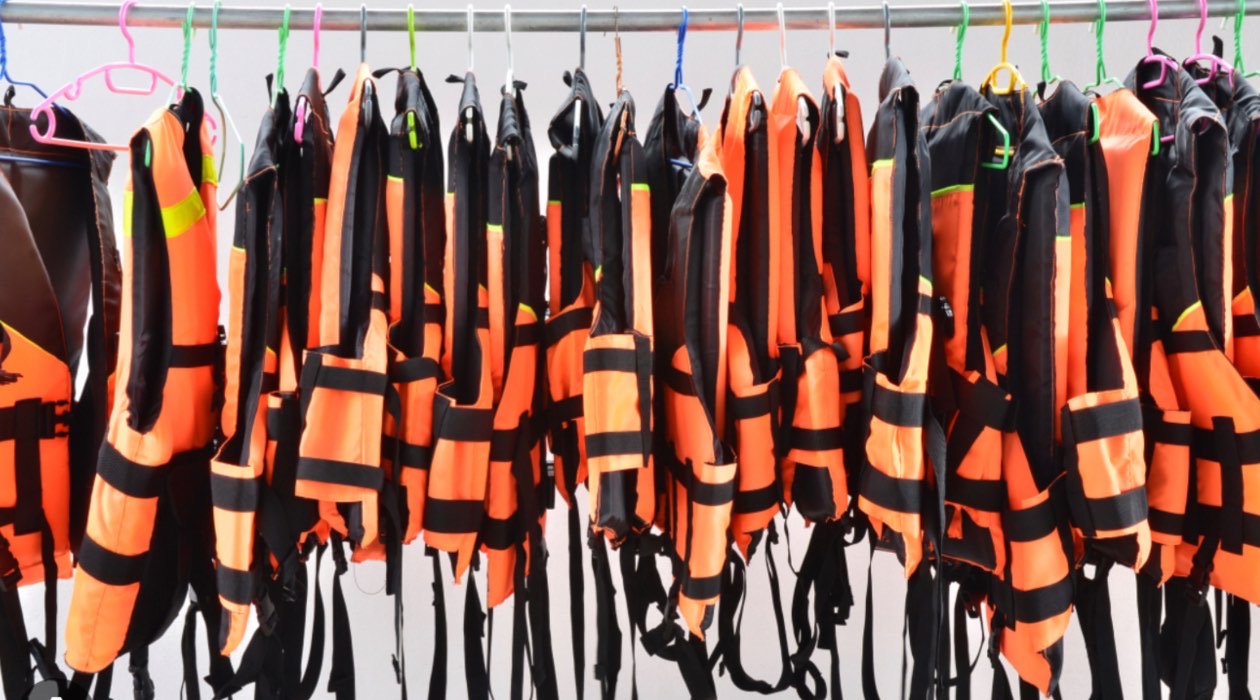

Articles
How To Store Life Jackets
Modified: December 7, 2023
Discover the best ways to store life jackets with our informative articles. Ensure your life jackets are properly maintained and ready for use at all times.
(Many of the links in this article redirect to a specific reviewed product. Your purchase of these products through affiliate links helps to generate commission for Storables.com, at no extra cost. Learn more)
Introduction
Welcome to our comprehensive guide on how to store life jackets. Life jackets are essential safety devices that can save lives during boating, water sports, and other water-related activities. However, proper storage is crucial to ensure their effectiveness and longevity. In this article, we will walk you through the steps to appropriately store and maintain your life jackets, keeping them in optimal condition for future use.
Storing life jackets correctly not only helps them maintain their buoyancy and durability but also extends their lifespan. Improper storage can lead to damage, mold, mildew, and decreased effectiveness in an emergency situation. By following the guidelines outlined in this article, you can ensure that your life jackets are always ready for use when you need them the most.
From choosing the right storage space to cleaning, drying, and utilizing various storage options, we will cover everything you need to know. Whether you’re a boat owner, water sports enthusiast, or simply a safety-conscious individual, this guide will provide you with essential tips and techniques for storing life jackets effectively.
Let’s dive into the details, beginning with the first step of choosing the right storage space for your life jackets.
Key Takeaways:
- Proper storage and maintenance of life jackets are crucial for their effectiveness and longevity. Follow the comprehensive guide to ensure your life jackets are always ready for use during water-related activities.
- From choosing the right storage space to regular maintenance, prioritize the proper storage and care of your life jackets to ensure safety and peace of mind during boating and water sports.
Read more: How To Store Winter Jackets
Step 1: Choosing the Right Storage Space
When it comes to storing life jackets, selecting the appropriate storage space is crucial. The ideal storage area should be dry, well-ventilated, and away from direct sunlight. Here are some factors to consider:
- Indoor vs. Outdoor: It is generally recommended to store life jackets indoors to protect them from weather elements and excessive sunlight. If indoor space is limited, consider using a covered outdoor area or a storage bin specifically designed for outdoor use.
- Avoiding Damp Areas: Moisture can lead to mold and mildew growth, which can compromise the effectiveness of your life jackets. Make sure the storage space is dry and has low humidity levels.
- Adequate Space: Ensure that the chosen storage area has enough space to accommodate all your life jackets without them being tightly squeezed together. This will help maintain their shape and prevent unnecessary wear and tear.
- Temperature Control: Extreme temperatures can deteriorate the materials of life jackets. Avoid storing them in areas that experience extreme heat or cold. Optimal temperature ranges from 10°C to 27°C (50°F to 80°F).
Consider these factors when selecting the storage space for your life jackets. Now that you have chosen the appropriate area, let’s move on to the next step – cleaning and drying the life jackets.
Step 2: Cleaning and Drying the Life Jackets
Before storing your life jackets, it is important to clean and dry them properly. This not only helps to remove dirt, salt, and other debris but also prevents the growth of mold and mildew. Here’s how to clean and dry your life jackets:
- Inspect for Damage: Before cleaning, carefully inspect the life jackets for any signs of damage such as tears, loose threads, or broken buckles. If you notice any issues, repair or replace the life jacket as necessary.
- Remove Excess Dirt and Debris: Use a soft brush or cloth to gently remove any dirt or debris from the surface of the life jackets. Pay close attention to straps, belts, and pockets.
- Spot Cleaning: For minor stains or soiled areas, you can use a mild soap or detergent mixed with water. Apply the solution to a clean cloth and gently scrub the affected areas. Avoid using harsh chemicals or abrasive cleaners, as they can damage the fabric.
- Rinse Thoroughly: After spot cleaning, rinse the life jackets thoroughly with clean water. Ensure that all soap residue is removed to prevent any skin irritation or fabric damage.
- Drying: Once the life jackets are clean, hang them in a well-ventilated area or use a drying rack. Avoid direct sunlight, as it can fade the colors and weaken the fabric. Allow the life jackets to air dry completely before moving on to the next step.
By following these cleaning and drying steps, you can ensure that your life jackets are clean, free of debris, and ready for storage. Now that the life jackets are fresh and dry, let’s learn how to fold or roll them properly in the next step.
Step 3: Fold or Roll the Life Jackets Properly
Properly folding or rolling your life jackets is essential to prevent creases and maintain their shape during storage. Here are two methods you can use:
- Folding Method:
- Lay the life jacket flat on a clean surface.
- Smooth out any wrinkles or folds.
- Fold one side of the life jacket towards the center, about halfway.
- Repeat the same fold on the other side, bringing it towards the center.
- Take the bottom of the life jacket and fold it up to meet the top edge.
- Once folded, secure the life jacket with straps or fasteners if available.
- Rolling Method:
- Lay the life jacket flat on a clean surface.
- Smooth out any wrinkles or folds.
- Starting from the bottom, tightly roll the life jacket towards the top.
- Ensure that the roll is firm and compact.
- Secure the rolled life jacket with straps or fasteners if available.
Choose the folding or rolling method that works best for you and your life jackets. The goal is to minimize creases and maintain the integrity of the life jacket’s materials. Once your life jackets are properly folded or rolled, it’s time to explore various storage options in the next step.
Step 4: Utilizing Hanging Storage Options
Hanging storage is a convenient and space-saving option for storing life jackets. It helps to maintain the shape of the jackets and allows for easy access when needed. Here are some tips for utilizing hanging storage:
- Hanging Hooks: Install sturdy hooks on the wall or use an existing rod or railing to hang your life jackets. Make sure the hooks are secure and can hold the weight of the jackets.
- Proper Placement: Hang each life jacket individually to prevent them from rubbing against each other, which can cause wear and tear. Leave enough space between jackets to ensure proper air circulation.
- Hanger or Strap: Consider using a hanger specifically designed for life jackets with straps or a loop to hold them in place. This helps to keep the jackets securely suspended and prevents them from slipping off the hanger.
- Well-Ventilated Area: Hang the life jackets in a well-ventilated area to allow for airflow, which helps in preventing moisture buildup and mold growth.
Utilizing hanging storage options keeps your life jackets organized, easily accessible, and in good condition. However, if hanging storage is not feasible for your situation, there are alternative options such as storing them in plastic containers, which we will explore in the next step.
Store life jackets in a cool, dry place away from direct sunlight and extreme temperatures. Hang them or lay them flat to prevent creasing or damage to the material. Regularly check for any signs of wear or damage.
Read more: How To Store Down Jacket
Step 5: Storing Life Jackets in Plastic Containers
If hanging storage is not an option for you, storing your life jackets in plastic containers can be a practical alternative. Plastic containers provide protection from dust, moisture, and potential damage. Follow these steps to store your life jackets in plastic containers:
- Select Suitable Containers: Choose plastic containers that are large enough to accommodate your life jackets without compressing them. Make sure the containers have tight-fitting lids to keep out dust and moisture.
- Clean and Dry: Before placing the life jackets in the containers, ensure they are clean and dry to prevent any mold or mildew growth inside the containers.
- Fold or Roll: Fold or roll the life jackets as mentioned in Step 3 and place them in the containers. Avoid overstuffing the containers to maintain the shape of the life jackets.
- Add Desiccant Packs: To prevent moisture buildup, consider adding desiccant packs, such as silica gel, to the containers. These packs help to absorb excess moisture and keep the life jackets dry.
- Label and Store: Label the containers with the contents and date of storage. Store the containers in a dry and cool area away from direct sunlight.
Storing life jackets in plastic containers offers protection and convenience, especially if you have limited space or if the jackets won’t be frequently used. However, it is important to regularly check the containers for any signs of moisture or mold and take appropriate action if necessary. Now, let’s move on to Step 6, where we discuss the impact of temperature and humidity on life jacket storage.
Step 6: Considering Temperature and Humidity Levels
The temperature and humidity levels in the storage area can significantly impact the condition and effectiveness of your life jackets. It’s important to consider these factors to ensure optimal storage conditions. Here are some guidelines to follow:
- Temperature: Extreme temperatures can degrade the materials of the life jackets. Avoid storing them in areas with excessive heat or cold. The optimal temperature range for storage is typically between 10°C and 27°C (50°F and 80°F).
- Humidity: High humidity can lead to moisture buildup, mold, and mildew growth, while low humidity can cause the materials to become brittle. Aim for a humidity level below 50% to prevent moisture-related issues. You can use a dehumidifier or silica gel packs to regulate humidity levels in the storage area.
- Climate Control: If possible, consider storing your life jackets in a climate-controlled environment. This helps maintain consistent temperature and humidity levels, ensuring the longevity of the jackets.
- Monitoring: Periodically check the storage area for any signs of moisture, mold, or extreme temperature fluctuations. If you observe any issues, take appropriate action to rectify them and maintain ideal storage conditions.
By considering temperature and humidity levels during life jacket storage, you can prevent damage, mold growth, and maintain the integrity of the jackets. Now, let’s move on to the final step, where we discuss the importance of checking and maintaining your life jackets regularly.
Step 7: Checking and Maintaining Life Jackets Regularly
Regular maintenance and inspections are crucial to ensure that your life jackets are in good working condition and ready for use when needed. Follow these steps to check and maintain your life jackets:
- Visual Inspection: Regularly inspect your life jackets for any signs of damage, such as tears, holes, or loose stitching. Ensure that all straps, buckles, and zippers are in proper working order.
- Floatation Test: Perform a floatation test by wearing the life jacket and entering the water. Verify that it provides proper buoyancy and keeps you afloat. If you notice any issues, such as excessive buoyancy loss or uncomfortable fit, it may be time to replace the life jacket.
- Mildew or Mold: Check for any signs of mildew or mold growth. If you find any, clean the affected areas using a mild detergent or mold remover and allow the life jacket to thoroughly dry before storing it again.
- Replace Damaged Parts: If you identify any damaged parts, such as buckles, straps, or reflective materials, replace them promptly. It’s important to maintain the integrity of the life jackets to ensure their effectiveness.
- Follow Manufacturer’s Recommendations: Refer to the manufacturer’s instructions and recommendations for maintaining and servicing your specific life jackets. They may provide additional guidelines on inspection, cleaning, and maintenance specific to the make and model of your life jackets.
By regularly checking and maintaining your life jackets, you can ensure that they are in optimal condition and ready to be used in case of an emergency. Additionally, staying up to date with maintenance helps extend the lifespan of your life jackets and promotes safety during water-related activities.
With these steps, you now have a comprehensive understanding of how to store and maintain your life jackets properly. By following this guide, you can ensure that your life jackets are always prepared to keep you safe during your water adventures. Stay safe, and enjoy your time on the water!
Summarize the main points of the article and conclude the article.
Conclusion
Proper storage and maintenance of life jackets are essential to ensure their effectiveness and longevity. By following the steps outlined in this comprehensive guide, you can confidently store your life jackets and keep them in optimal condition for future use.
Choosing the right storage space, cleaning and drying the life jackets, folding or rolling them properly, utilizing hanging storage options or plastic containers, considering temperature and humidity levels, and regularly checking and maintaining the life jackets are all crucial steps in the storage process.
Remember to select a dry and well-ventilated storage area, clean the life jackets regularly, fold or roll them carefully to avoid creases, utilize hanging storage options or plastic containers, monitor temperature and humidity levels, and conduct regular inspections to ensure the integrity of the life jackets.
By taking these steps, you can ensure that your life jackets remain in top-notch condition, ready to provide safety and protection during boating, water sports, and other water-related activities. Prioritizing the proper storage and maintenance of your life jackets will give you peace of mind, knowing that you are well-prepared for any emergency situation that may arise.
So, whether you are a boat owner, water sports enthusiast, or simply someone concerned with safety, make sure to implement these practices for storing and maintaining your life jackets. Stay safe and enjoy your time on the water!
Frequently Asked Questions about How To Store Life Jackets
Was this page helpful?
At Storables.com, we guarantee accurate and reliable information. Our content, validated by Expert Board Contributors, is crafted following stringent Editorial Policies. We're committed to providing you with well-researched, expert-backed insights for all your informational needs.















0 thoughts on “How To Store Life Jackets”